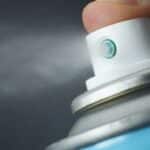Huffing (inhaling) paint thinner gets you high. Paint thinners are volatile solvents, which means they change to vapor at room temperature. Inhaling those vapors can make you feel more stimulation and less inhibition. It can also kill you.
Who Huffs Paint Thinner?
The people who are most likely to huff paint thinner are high school students. In 2020, 2.7 percent (683,000) people between 12 and 17 admitted to use of inhalants, according to the National Survey on Drug Use and Health (NSDUH).
There are several reasons that inhalant abuse is most prevalent among this age group:
- adolescents have less access to illicit drugs or alcohol
- inhalants are cheaper than drugs
- inhalants are legal
- parents often don’t suspect a problem with inhalants
- young people are experimenting and haven’t moved on to stronger substances
- teens feel that getting high on a household product is less dangerous than doing hard drugs
Effects Of Huffing Paint Thinner
When you huff paint thinner, it affects the way your brain works. You may have more energy but less control over what you’re doing. Huffing impairs your judgment and can lead to dangerous behavior.
Some paint thinners contain xylene (Xylol), which depresses the central nervous system, so you may experience sedation and confusion.
Other short-term effects of huffing paint thinners include:
- dizziness
- a dazed state
- slurred speech
- loss of appetite
- nausea
- runny nose
- hallucinations
- giddiness
- clumsiness
- slow reaction time
The intensity of a paint thinner high depends on how much you inhale and how you breathe it in.
How Huffing Works
“Huffing” is the term for holding a rag soaked in paint thinner up to your face or putting it in your mouth. Some people sniff it from the container (“sniffing”) or put it in a plastic bag and inhale it (“bagging”).
Since huffing and bagging bring you into close contact with the paint thinner, they produce an intense high and are very dangerous.
Dangers Of Huffing Paint Thinners
Huffing paint thinner can kill you in several ways. If it doesn’t, it’s likely to damage your organs and impair brain function.
Paint thinner inhalation can cause death from suffocation (asphyxiation). It fills your lungs with toxic substances and prevents you from breathing oxygen. You could also take a fatal dose by inhaling too much. Overdose is especially risky with bagging.
Sudden Sniffing Death
If you sniff paint thinner too many times in a row, it can cause an irregular, racing heart rate that leads to death within minutes, even if it’s the first time you’ve done it. This condition is called sudden sniffing death syndrome (SSDS).
Huffing paint thinner may cause seizures, choking, coma, and fatal accidents from intoxication. High doses of xylene can cause sleepiness, loss of consciousness, and death in high doses.
Toluene & Brain Damage
The primary chemical in many paint thinners is toluene, which makes up 60 to 70 percent of the substance. Breathing in toluene can cause brain damage and other adverse long-term effects, such as:
- irritability
- depression
- memory problems
- difficulty concentrating
- impaired cognitive function
- difficulty balancing
- limb spasms
- hearing loss
- vision loss
- muscle weakness
- liver damage
- kidney damage
- damage to the reproductive system
Paint Thinner Withdrawal Symptoms
If you regularly huff paint thinners, you’ll likely experience withdrawal symptoms if you stop.
Paint thinner withdrawal symptoms may include:
- difficulty sleeping (insomnia)
- nausea and vomiting
- hallucinations
- seizures
- rapid heart rate
- sweating
- hand tremors
- cravings
The unpleasant and uncomfortable withdrawal process makes it hard to stop huffing, but continuing can lead to much worse consequences.
Other Types Of Inhalants
Paint thinner isn’t the only kind of inhalant that people abuse. Inhaling fumes from aerosol cans or any potent chemical mixture can cause intoxication.
Other types of inhalants that can get you high are:
- nail polish remover
- spray deodorant
- spray paint
- correction fluid
- lighter fluid
- butane
- propane
- nitrites (“poppers”)
- nitrous oxide (“laughing gas”)
Signs & Symptoms Of Inhalant Abuse
If you’re concerned that a loved one is using drugs but aren’t sure what, consider whether they could be abusing inhalants. It doesn’t always occur to parents that their kids could be getting high on something seemingly harmless found around the house.
Signs and symptoms of inhalant abuse include:
- red or watery eyes
- constant runny nose
- sores or irritation around the mouth or nose
- lack of coordination
- slurred speech
- unusual boldness
- irritability
- lightheadedness that may cause fainting
- moodiness that may include violent behavior
- chemical odors on the person
- inhalants like paint thinner hidden in their room or somewhere they shouldn’t be
If you think someone is abusing inhalants, don’t ignore the problem. Approach them when they’re sober in a loving and supportive manner. Encourage them to get help before it’s too late.
Treatment For Huffing Paint Thinners
Huffing paint thinner is substance abuse and should be treated like drug addiction. The best treatment centers offer personalized care and will work with you to create an addiction treatment plan.
Treatment for inhalant abuse is based on behavioral therapy, which examines how your thought patterns lead to unhealthy behavior and works to change how you think and act. Other treatment methods include support groups, exercise, and mental health counseling.
At Northeast Addictions Treatment Center, we provide outpatient rehab programs that allow you to live at home while in recovery. We have several levels of care depending on the severity of your inhalant addiction. Speak with one of our treatment specialists today to learn more.
Sources
Written by
Northeast Addition Editorial Team
©2024 Northeast Addition Center | All Rights Reserved
This page does not provide medical advice.




